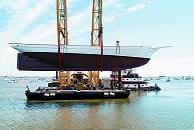I enjoyed the article by Robert A. Orr about his days as commanding officer of a 328-foot landing ship-tank (LST 887) in the Pacific ("Downwind boat recovery," Issue No. 57).
While westing to San Francisco from the Philippines in 1946 on a month-long voyage, he faced the challenge of evacuating an injured crewman to another vessel in dicey sea conditions. Emphasizing the difficulty surrounding the transfer of crewmen between vessels at sea, he further stated, "In the modern age, helicopters and sophisticated, computer-controlled ‘breeches-buoy’ lines have nearly eliminated the use of small craft for accomplishing this task."
As our 210-foot cutter, Diligence (WMEC 616), returns home from a month-long patrol in the Windward Passage, we have just completed a series of missions which required personnel transfers amidst the full spectrum of Caribbean sea conditions one can expect during the winter season. Our cases may involve the medevac (medical evacuation) of an injured boater, but often include the rescue of 50 to 150 Haitian migrants from an unseaworthy and overloaded craft in choppy seas, or sending a boarding team to investigate a vessel suspected of smuggling contraband. This is the context in which today’s Coast Guardsmen discuss the issue of small boat operations.
Several members of our wardroom enjoyed the author’s reference to more sophisticated methods currently used at sea. As Coast Guard modernists, we have yet to come across the computer-controlled rig described, and can say with assurance that over the past 50 years little has changed with respect to transferring personnel (or boarding teams) to another vesselit’s still done by small boat, often in implacable sea conditions!
Although transfers are now done with a more seaworthy 5-meter rigid-hull inflatable, or 25-foot motor surf boat (rather than a pulling boat or LCVP), today’s Coast Guardsmen are still launching and recovering small boats through surf and storm to deliver the goods. Readers forced to make a (hopefully rare) call for help or enjoy a visit from one of our boarding teams, can still expect to see our cutters launch a small boat to render assistance or conduct an inspection.
The author described a unique recovery method he employed successfully in a storm-driven swell, derived from his earlier seamanship experience on the square-rigger Danmarka barque used by the Coast Guard Academy during World War II to train cadets (alongside the Danish crew). Remaining in close proximity to the assisting Navy transport and steaming the LST down-swell, he had the small boat match their cruising speed to remain in-step, which then allowed the LCVP to safely hook-up. The key was to minimize any relative motion between the two vessels, and achieve no rise and fall or swinging in and out while riding on the ship’s sea painter. This technique is still in use today and remains the launch/recovery method of choice for many cutters, especially when faced with a considerable surf or running seaway.
Based on frequent boat operations with some of our 110-foot Island-class coastal patrol boats, and 210-foot Reliance-class cutters, which deploy well off soundings, we would also favor a down-sea launch and recovery. However, to minimize the small boat’s transit distance, we would position the cutter so the small boat could run down-swell while approaching and departing the other vesselthis differs slightly from the method used in the LST scenario. After forcing a coxswain to beat up-swell with an injured passenger or with a fully-equipped boarding team in six- to 12-foot seas, a conning officer may receive unsolicited advice from the water-logged boat crew.
Furthermore, rather than aligning directly parallel to the direction of the swell, we would alter course slightly to create a small area of calm water to leeward of the launching/recovering vessel (see accompanying diagram). So, we might launch the small boat on a down-sea course (1) with the wind on the windward quarter of the cutter, allowing the small boat to run down-swell to the assisting vesselwhich also selects a favorable course (2) to create a protected lee for the approaching small boat. After making the transfer, the small boat runs down-sea again to the recovery position on the leeward side of cutter (3).
Today’s cutters probably conduct small boat operations with more regularity than the Coast Guard-manned LSTs of the past, and new boathandling techniques have evolved. However, many qualities and skills of good seamanship have endured and remain in use today. The boat crew is no longer required to boat the inboard oars at just the right time, or climb hand-over-hand up the manropes before hoisting the boat off the water, but we still use Captain Orr’s method of downwind boat recovery in heavy weather.
Dane S. Egli is a lieutenant commander in the Coast Guard.

